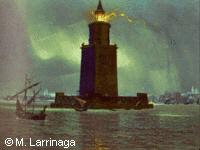|
   






 |

 | Intro:
Of the Seven Wonders of the world, only one had a practical use in addition to
its architectural elegance: The Lighthouse of Alexandria. For sailors, it ensured a safe |
|
 |
return to the Great Harbor. For architects, it meant evenmore: it
was the tallest building on the Earth. And for scientists, it was the mysterious mirror
that fascinated them most... a mirror which reflection could be seen more than 50 km (35
miles) off-shore.
 | Location:
On the ancient island of Pharos, now a promontory within the city of Alexandria
in Egypt.
|
 | History:
Shortly after the death of Alexander the Great, his commander Ptolemy Soter
assumed power in Egypt. He had witnessed the founding of Alexandria, and established his
capital there. Off of the city's coast lies a small island: Pharos. The island was
connected to the mainland by means of a dike - the Heptastadion - which gave the city a
double harbor. And because of dangerous sailing conditions and flat coastline in the
region, the construction of a lighthouse was necessary.
The project was conceived and initiated by Ptolemy Soter around 290 BC, but was completed
after his death, during the reign of his son Ptolemy Philadelphus. For centuries, the
Lighthouse of Alexandria (occasionally referred to as the Pharos Lighthouse) was used to
mark the harbor, using fire at night and reflecting sun rays during the day. It was even
shown on Greek and Roman coins, just as famous monuments are depicted on currency today.
When the Arabs conquered Egypt, they admired Alexandria and its wealth. The Lighthouse
continues to be mentioned in their writings and travelers accounts. When the mirror was
brought down mistakenly, they did not restore it back into place. In AD 956, an earthquake
shook Alexandria, and caused little damage to the Lighthouse. It was later in 1303 and in
1323 that two stronger
earthquakes left a significant impression on the structure. When the famous Arab traveler
Ibn Battuta visited Alexandria in 1349, he could not enter the ruinous monument or even
climb to its doorway.
The final chapter in the history of the Lighthouse came in AD 1480 when the Egyptian
Mamelouk Sultan, Qaitbay, decided to fortify Alexandria's defense. He built a medieval
fort on the same spot where the Lighthouse once stood, using the fallen stone and marble.
|
 | Description:
From the six vanished Wonders, the Lighthouse of Alexandria was the last to
disappear. Therefore we have adequately accurate knowledge of its location and appearance.
Ancient accounts such as those by Strabo and Pliny the Elder give us a brief description
of the "tower" and the magnificent white marble cover. They tell us how the
mysterious mirror could reflect the light tens of kilometers away. Legend says the mirror
was also used to detect and burn enemy ships before they could reach the shore. |

|
|
|
